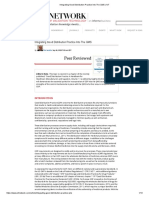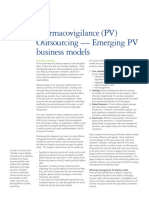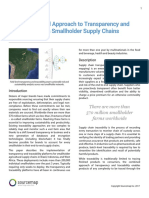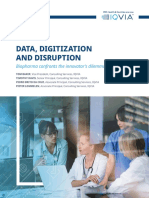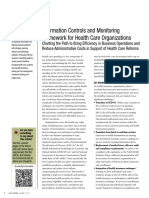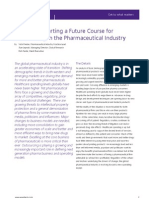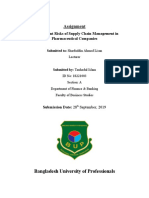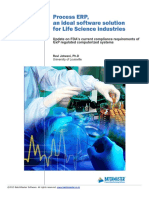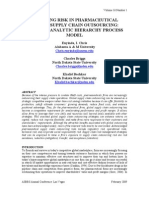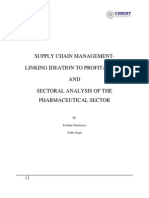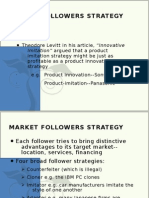Serialization Driving Business Value Beyond Compliance Codex1498
Serialization Driving Business Value Beyond Compliance Codex1498
Uploaded by
Maria Alice Cabral MaiaCopyright:
Available Formats
Serialization Driving Business Value Beyond Compliance Codex1498
Serialization Driving Business Value Beyond Compliance Codex1498
Uploaded by
Maria Alice Cabral MaiaOriginal Title
Copyright
Available Formats
Share this document
Did you find this document useful?
Is this content inappropriate?
Copyright:
Available Formats
Serialization Driving Business Value Beyond Compliance Codex1498
Serialization Driving Business Value Beyond Compliance Codex1498
Uploaded by
Maria Alice Cabral MaiaCopyright:
Available Formats
• Cognizant 20-20 Insights
Serialization: Driving Business Value
Beyond Compliance
As serialization and track-and-trace capabilities go mainstream to
meet regulatory compliance mandates, pharmaceuticals companies
should simultaneously explore how these tools and techniques can
improve supply chain planning and operations, elevate patient and
doctor engagement, and increase sales and marketing effectiveness.
Executive Summary greater efficiencies and effectiveness through
higher visibility and collaboration. Pharmas can
High-value products, complex supply chains,
use serialization data in multiple ways, including
dependence on multiple organizations for dis-
collecting inventory information across supply
tribution — all of these factors expose the
nodes, monitoring the performance of execution
pharmaceuticals industry to threats such as coun-
partners, cold chain monitoring and recall man-
terfeiting, theft and illegal diversions. In fact, the
agement; by doing so, they can bolster real-time
Pharmaceutical Security Institute counts 2,177
decision-making capabilities and increase supply
incidents of counterfeiting worldwide in 2014
chain agility. Serialization data can considerably
alone.1 To counter these threats and ensure the
strengthen fraud-prone process areas, such as
integrity of the pharma supply chain, regulatory
returns and chargebacks, as well as illegal diver-
initiatives are under way worldwide that mandate
sions, yielding direct savings for all supply chain
serialization of medical products sold globally,
partners.
as well as the tracking and tracing of products
throughout the supply chain. The U.S., China, Serialization also provides pharmaceuticals
South Korea, EU, Argentina, Brazil and other companies with a way to connect directly with
regions of the world are all in different phases of patients through patient-centric initiatives,
implementing serialization- and track-and-trace- strengthen their patient services portfolio and
related regulations. ensure brand loyalty. Patient authentication data,
for example, can be used to geographically map
While regulatory compliance remains a top priority
customers and ensure adequate availability at
for pharmaceuticals companies, the availability of
the nearest pharmacy. Serialization authentica-
information about serialized products throughout
tion can also help optimize refill management,
the supply chain provides a unique opportunity
appointment bookings, patient education and dis-
for pharmas to take a data- and analytics-driven
ease management, among other services.
approach to supply chain improvements that yield
cognizant 20-20 insights | september 2015
Pharmaceuticals companies can also use serial- Tamper-proof packaging and Within the next five
ization data to identify the relative performance 3-D holograms were among
of various market segments to drive targeted the earliest approaches years, approximately
sales and marketing initiatives. They can then undertaken by the industry 65% of the global
analyze these interventions and programs and and government regulators market is expected to
further fine-tune them, thereby increasing sales to address counterfeiting.
effectiveness and marketing spend efficiency. However, these efforts are require serialization
now viewed as insufficient, in the supply chain.
When initiating serialization projects, phar- as such packaging has been
maceuticals companies must look beyond found to be vulnerable to manipulation. Recent
regulatory compliance to design the underlying regulatory initiatives — such as product serial-
infrastructure, applications and processes that ization (i.e., assigning a unique identification
drive value through new and supplemental busi- number to every saleable pharmaceuticals prod-
ness capabilities. uct unit) and product tracking in the supply chain
(through pedigree documentation and/or regu-
This white paper explores the many ways that
latory reporting) — are under way to address
new serialization capabilities can be utilized to
counterfeit drug concerns. Serialization and
drive business value across corporate functions
track-and-trace regulations are already active
and activities, thus enhancing the return on
and enforced in numerous countries, such as
investment (ROI) to achieve regulatory compli-
Turkey, Argentina and China. Additional coun-
ance, globally.
tries, such as the U.S., Korea and Brazil, as well
The Serialization Context as members of the EU, are in the process of
implementation or finalizing such regulations.
The pharmaceuticals industry has faced chal-
Within the next five years, approximately 65% of
lenges over the years to ensure the integrity of
the global market (by value, as of 2014 revenue
products as they move across the supply chain,
data) is expected to require serialization in the
from the manufacturing base to the patient.
supply chain.4
These supply chains are also becoming increas-
ingly complex as pharmaceuticals companies Driving Business Value from
segue toward specialty products and focus on Serialization
lifestyle diseases. This has made it more difficult
We have worked closely with major pharma-
for pharmas to devise secure
ceuticals companies to explore and define
According to the supply chain strategies to additional dimensions for creating business
close loopholes and avoid
World Health losses. value and increasing the ROI of their serialization
Organization (WHO), compliance-related investments. A serialization
According to the World Health compliance infrastructure enables two primary
the pharmaceuticals Organization (WHO), the capabilities — supply chain and consumption vis-
industry loses nearly pharmaceuticals industry ibility — that can be leveraged for additional use
$40 billion each loses nearly $40 billion each cases and as value drivers (see Figure 1, next
year globally due to counter- page).
year globally due to feiting.2 Product theft has
counterfeiting. also increased; according to
Inventory Optimization
Freight Watch International, We recently conducted a benchmarking study5
drugs account for about 15% of the estimated $8 to evaluate the current state of pharmaceuti-
billion to $12 billion in annual cargo theft.3 cals supply chains as compared with those of
fast-moving consumer goods (FMCG) companies
Counterfeiting and theft not only leads to losses (typically considered a best-in-class benchmark in
worth billions of dollars in potential sales oppor- supply chain design, execution and performance
tunity, but it also increases patient safety risk. metrics). Our study found that, in general, the
Industry players also incur additional costs to pharmaceuticals industry is serving its market
manage product recalls once counterfeit batches as reliably as the FMCG industry, but at a much
have been identified. Lastly, negative publicity higher service cost.
related to counterfeiting and recalls have a direct
impact on brand image and future sales revenues. The first set of metrics compared supply chain
performance and reliability. Our analysis indicat-
cognizant 20-20 insights 2
Serialization Dimensions to Drive Value Beyond Compliance
Optimizing Supply Chain Sales & Demand
Recalls & Operations Marketing Forecast
Returns Monitoring Effectiveness Improvement
Inventory Addressing Illegal Patient-Centric
Brand Loyalty
Optimization Diversions Engagements
Supply Chain Visibility Consumption Visibility
Serialization &
Track-and-Trace
Infrastructure
Figure 1
ed that the pharmaceuticals industry is, in general, stakeholders by increasing agility and responsive-
on par with the FMCG industry in on-time-in-full ness, as well as optimizing inventory levels and
(OTIF) and forecast accuracy (see Figure 2).
However, when we compared these two industries
costs across various supply chain levels or inven-
tory-stocking locations. 2
#
on asset efficiency measures, we found that the For supply chain planners, a fundamental busi-
actual cost of attaining the same level of supply ness goal is optimizing inventory across the
chain reliability is much higher for the phar-
maecuticals industry (see Figure 3, next page).
Consumer goods supply chains, on average, com- Measures of Reliability
pleted their conversion of asset resources to
cash five times faster than pharmaceuticals. In On measures of reliability,
terms of actual inventory turnover, the consumer both FMCG and pharma have
similar performance levels.
goods industry was three times faster than the
pharmaceuticals industry. By focusing on this
area, pharmaceuticals companies could directly
improve their returns on equity.
97.4% 97.5%
By combining serialization with track-and-trace
supply chain event recording within databases
75% 72.3%
that are compliant with the Electronic Product
Code Information Services (EPCIS) standard,
industry players and their partners could real-
ize an additional supply chain platform to gauge
product movement, facilitate tighter collabo-
ration and/or enable more coordinated supply On-time-in-full Forecast Accuracy
chain planning. The same infrastructure deployed
for serialization track-and-trace regulatory Pharmaceuticals Fast-Moving Consumer Goods
compliance can also serve a broader group of
Figure 2
cognizant 20-20 insights 3
in multiple areas, such as
Measures of Asset Efficiency With event data
logistics. An important first
step is for internal warehous- enabled by
FMCG converts resources to
cash five times faster and ing and distribution teams serialization and
turns inventory three times to develop performance
faster than pharma. track-and-trace,
metrics and benchmarks
to manage external service companies have
providers. To enable a truly additional information
performance-driven supply
10.6 they can use to more
chain, pharmaceuticals com-
panies need mechanisms to effectively monitor
7.6 monitor the performance — and improve —
indicators of different ful-
underlying business
fillment teams and make
real-time decisions. processes.
2.2 2.5
Pharmaceuticals companies are working with
Cash Conversion Cycle Inventory Turnover their supply chain partners to establish and track
(No. of Days) x 10 (Multiple of) key performance indicators (KPIs) as part of their
Pharmaceuticals Fast-Moving Consumer Goods
supply chain contracts. But challenges remain to
effectively implement and monitor these metrics,
Figure 3 as well as gain dynamic visibility into changing
conditions in the supply chain. A serialization and
supply chain while improving customer service. track-and-trace infrastructure can be used to cap-
The net inventory maintained at any customer ture and extract business transaction events (i.e.,
demand location to deliver superior customer shipments, receipts and suspect products) and
service must typically be balanced with the costs provide data and event management feedback in
of maintaining inventory at those locations (i.e., real time to support KPI monitoring, supply chain
carrying, storage, security and obsolescence). dashboards, support inventory and cold chain
Stockouts not only result in lost opportunities monitoring, and decision support.
for revenue generation but
With event data enabled by serialization and
According to a 2013 also may potentially impact
track-and-trace, companies have additional
patient health and supply
report, Premier chain partner performance. information they can use to monitor underlying
Healthcare Alliance business processes more effectively and leverage
According to a 2013 report, process improvement opportunities across orga-
estimated that the Premier Healthcare Alliance nizational units and supply chain partners. They
annual cost of drug estimated that the annual can also effectively benchmark and improve ser-
shortages for U.S. cost of drug shortages for U.S. vice delivery standards across the organization.
hospitals was $416 million.6 Cross-organizational collaboration provides vis-
hospitals was $416 By implementing serializa- ibility into the underlying processes and makes
million. tion technologies that enable execution-related information available to all rele-
inventory visibility across the vant stakeholders, thus allowing the entire supply
supply chain, pharmaceuticals companies have chain ecosystem to improve as one unit.
an additional source of near-real-time inventory
Optimizing Reverse Logistics:
event data that can be used to optimize invento-
Returns & Recalls
ry levels, shorten replenishment lead times and
avoid stockouts. The pharmaceuticals industry incurs about $2 bil-
lion annually in costs associated with processing
Supply Chain Operations Monitoring returns, expirations and recalls, according to a
The ability to increase supply chain visibility and study by the Healthcare Distribution Management
quickly respond to specific events can be a major Association (HDMA).7 A lack of accurate audit
advantage in the competitive pharma market- trails and product authentication capabilities for
place. Externalization of supply chain activities reverse logistics exposes the industry to fraud
has increased dependence on service providers and inefficiencies. Serialization and track-and-
cognizant 20-20 insights 4
The pharmaceuticals trace capabilities fill these Similarly, pharmaceuticals companies have
industry incurs about gaps directly and can be responded to pricing pressures from group pur-
used to redesign reverse chasing organizations (GPOs), whose influence
$2 billion annually in logistics processes. on product volumes is significant enough to allow
costs associated with for price discount contracts. The process of plac-
For example, supply chain
processing returns, partners have many rea-
ing price discount contracts with wholesalers
that sell products to GPO members has result-
expirations and recalls, sons for initiating a return ed in the development of a chargeback process
according to a study by of goods, such as expiry of under which the wholesaler claims the extra dis-
products, recalls, packag-
the HDMA. ing damages, etc. A product
count provided to GPOs from pharmaceutical
companies.
authentication capability can greatly help various
supply chain partners to verify products when ini- From the pharmaceuticals company’s viewpoint,
tiating returns. the challenge of the chargeback reconciliation
process is that wholesaler sales data is usual-
Once authenticated, the physical product can be ly unavailable to the manufacturer and must be
shipped directly to the designated place for the obtained from third parties. Sales reconciliation
manufacturer to handle it, based on its status. The typically takes place at the product/quantity/
ensuing supplemental information, and associat- customer level and not always at the lot level,
ed credit notes arising from the returns process, much less at the serialized lot level. Within the
can now follow throughout the entire supply U.S. market, a serialization track-and-trace infra-
chain — all the way to the desired beneficiary, structure and the associated serialized lot level
based purely on the initial shipment details of the event (shipment) capture can provide new ways
serialized product. Doing so saves a significant for pharmaceuticals companies and wholesalers
amount of time and money that would otherwise to work together to streamline the reconciliation
have been spent on reverse logistics and verifi- processes, ensure chargeback payment accuracy,
cation processes across the many entities in the save money and channel these savings into initia-
supply chain. An authentication process can help tives that allow for additional market incentives.
companies identify and stop scenarios arising
from fraudulent activities or counterfeiting that Driving Patient-Centric Engagements &
exploit loopholes in the returns/recall process. Brand Loyalty
Aided by advances in technology, healthcare is
Addressing Diversions and Chargeback
undergoing a consumer-
ism revolution. Patients Serialization provides
Reconciliation
Product diversion (from different countries or are actively getting a very useful entry
consumer segments) is a real problem for phar- involved in decision-mak-
maceuticals companies especially because of ing processes that are point and interface
arbitrage opportunities arising from country informed by a variety for pharmaceuticals
or consumer segment pricing differentials. As of primary and second- companies to capture
pharmaceuticals companies have adapted to ary information sources.
the market-driven realities of tiered pricing and Pharmaceuticals com- patient behavior
rebating across customer segments (managed panies have scaled up and engage directly
markets), they are increasingly challenged to their strategic capabili- with them.
ensure that discounted consignments meant for ties to engage patients
specific customers or geographies are consumed digitally across the disease lifecycle. Serialization
by their intended targets rather than being divert- provides a very useful entry point and inter-
ed elsewhere. face for pharmaceuticals companies to capture
patient behavior and engage directly with them.
With serialization, companies can identify and
segregate the products intended for different Authentication is a key benefit of patient-focused
market and customer segments. Authentication functionality based on serialization infrastruc-
capabilities can help validate whether products ture. Encouraging patients to authenticate the
are consumed in the market or customer seg- products they buy can yield important informa-
ment for which they were earmarked. tion that can be used in a variety of ways (see
Figure 4, next page).
cognizant 20-20 insights 5
Serialization Driving Patient Services
Collaboration
with healthcare
providers (HCPs)
Disease awareness
HCP
intervention
Disease management/
regimen adherence
Authentication
Point of purchase Geographical Forum/community-
mapping of patients based services
Patient
engagement
Availability of
product refill at
Product point of purchase
fulfillment
Figure 4
The ease of authentication will increase with the Geographical information about patient popula-
rise in mobility. Of the 500 million smartphone tions that are consuming a given product can help
users worldwide, many will use a healthcare appli- pharmas design disease awareness and manage-
cation by the end of this year, and by 2018, half of ment programs for the patient community located
the more than 3.4 billion smartphone and tablet in those specific geographies. Pharmaceuticals
users worldwide will have downloaded a mobile companies can actively collaborate with health-
health app.8 care practitioners based on patient density and
help engender practitioner and patient trust,
A pharmaceuticals product
By the end of authentication tool can be
fostering a sense of partnership and increasing
brand loyalty.
this year, and by added to a mobile application
2018, half of the via GPS tracking and location- Pharmaceutical product authentication tools can
aware software to provide also be used to capture product SKUs purchased
more than 3.4 geographical mapping of by patients. When merged with prescription data,
billion smartphone patients and their purchase authentication data can help track regimen com-
and tablet users points. This information can pliance, which remains an area of concern for all
be helpful in that ensuring an healthcare practitioners. Such data can also help
worldwide will appropriate supply of drugs is pharmaceuticals companies more effectively pre-
have downloaded a maintained at relevant phar- dict when a patient will run out of a medication
mobile health app. macies. Additionally, it can and proactively send refill reminders. Relevant
provide unparalleled visibility entities on the supply side can also be notified
into real-time sales data that can be used for just- about the need for a particular product at a par-
in-time decision-making for avoiding stockouts ticular location as designated by the patient, thus
and planning alternate fulfillment mechanisms helping to transform the entire supply chain
when a pharmacy is dangerously out of stock on into a demand-driven engine that will power the
a particular pharmaceutical, as well as for fine- emerging era of personalized medicine.
tuning forecasting models to accurately reflect
future product requirements.
cognizant 20-20 insights 6
Relevant entities We believe that pharma- increased authentication data and can loop back
on the supply side ceuticals companies should to the decision model, fueling sales or marketing
integrate serialization-relat- activities.
can also be notified ed capabilities within their
about the need for a patient-connect-related digi- Serialization can help marketing departments
address two challenges: identifying micro-mar-
particular product at tal initiatives. In general, the
kets that need intervention (where to spend)
industry is just starting to
a particular location develop mobile applications and evaluating the effectiveness of intervention
as designated by the related to disease and prod- (what to spend on); both are important dimen-
sions to assess ways of increasing marketing
patient, thus helping ucts. As a result, the time
spend effectiveness. Authentication data aris-
is right to launch and pro-
to transform the mote authentication services ing from serialization-related capabilities can
entire supply chain through remote platforms. help with identifying market segments that need
intervention, enabling targeted initiatives to be
into a demand-driven Pharma companies must
undertaken. Serialization provides an additional
develop back-end business
engine that will processes that leverage data tool to evaluate the effectiveness of intervention,
power the emerging collected through authenti- as any insight into authentication volume (posi-
tive, negative or no change) is a good measure
era of personalized cation workflows to build and
of the effect of intervention. These insights can
deliver personalized services
medicine. for patients and practitioners, then be used to design better, more personalized
a move that would benefit the entire healthcare marketing programs.
ecosystem.
Laying the Foundation
Improving Sales and Marketing Effectiveness The business case is highly favorable for utilizing
Pharmaceuticals companies spend enormous serialization data to optimize existing processes
amounts of money on educating healthcare or develop new capabilities to address underlying
practitioners about the benefits of their brands unmet need. But to successfully implement the
and promoting their products to this community. use cases, the pharmaceuticals industry needs to
While secondary information sources are avail- address the foundational issues that will provide
able from various market research organizations a framework for all to benefit when investments
(MROs) that can be used to assess sales perfor- are made in developing serialization capabilities.
mance across target segments and geographical
regions, serialization capabilities can also be used Data related to EPCIS events across supply chain
to gather performance-related indicators to gen- entities needs to be accessed, collated and ana-
erate ground-level intelligence, thus leading to lyzed for supply chain visibility-related initiatives.
increased sales and marketing effectiveness. In This data may be available in a central reposi-
fact, as of 2012 (the last year for which data is tory in countries like China, where regulatory
available), $24 billion was spent by the pharma- agencies are the sole custodian of data that is
ceuticals industry on marketing to physicians.9 recorded and exchanged between different enti-
ties in the pharmaceuticals supply chain. In other
Serialization can Geographical information on countries, such as Turkey, data may be captured
patient populations can be in local repositories of different supply chain enti-
help marketing generated through patient ties, such as CMOs, distributors, wholesalers and
departments identify authentication data. The pharmacies. The industry needs to work with
micro-markets that overall effectiveness of the the regulatory agencies and their supply chain
sales force around brand pro- partners to drive consensus and formulate data-
need intervention motions can be quantitatively sharing agreements.
and evaluate evaluated, and specific coun-
Another challenge that pharmas face is the
the effectiveness of ter-measures can be taken in
limited focus on aggregating vast amounts of
areas that are lagging. This
intervention. geographical data can be fur- serialization data to enable business intelligence.
ther used to segment healthcare providers and Niche product vendors are providing capabilities
take appropriate measures (i.e., educating and that address regulatory compliance, while infra-
addressing practitioner concerns or extending structure providers are addressing activities that
patient services). The outcome of these sales/ keep the business running as usual. Utilization of
marketing measures can be measured through technologies such as cloud-based big data analyt-
cognizant 20-20 insights 7
ics could provide some answers — if security and to facilitate interoperable data exchange — but
cost-related concerns are adequately addressed. much more needs to be done.
Another area of deliberation is the lack of a Implementation Framework
global/regional security model that defines the Given the external dependencies that need to
guidelines for data access by various supply chain be factored in, pharmaceuticals companies must
partners. Visibility of serialization data is current- undertake a phased approach to implementing
ly limited by regulatory constraints imposed by serialization initiatives. Technical capabilities,
regional authorities. These regional regulatory such as authentication services, geographical
authorities dictate the standards for data access mapping and EPCIS event capturing, can be lever-
and data exchange. A step in the right direction aged across different use cases to ensure higher
was taken by member companies of Rx-360,10 ROI on those fronts. Figure 5 outlines consider-
an international pharmaceuticals supply chain ations that can help pharmaceuticals companies
consortium, when they met to establish a global advance their decision-making.
traceability data exchange architecture in order
A Serialization Decision Matrix
Business
Initiatives Technology Requirements External Dependency Our Recommendations
Value
Inventory High • Access to EPCIS events • Consensus among • Make inventory
optimization across supply chain supply chain partners optimization across
entities. for sharing event the supply chain
• Analytics platform to information. a shared business
collate and process • Adherence to common goal for all supply
chain partners.
EPCIS event data technology standards,
addressing different such as EPCIS, across • Establish a high
business use cases, organizations. degree of transpar-
such as reorder level, ency and collabora-
stockout warnings, tion, as both are
inventory imbalances, crucial for the
etc. initiative to succeed.
Supply chain Medium • Access to EPCIS events • Consensus among • Establish common
operations across supply chain supply chain partners benefits for supply
monitoring entities. for sharing event chain partners to
• Analytics platform to information. deploy reliable
collate and process • Adherence to and cost-effective
services with
EPCIS event data. technology standards,
real-time capabili-
• Dashboard for real-time such as EPCIS, across
organizations. ties to monitor and
monitoring of KPIs for
take timely actions.
supply chain execution • Agreement on KPIs
vendors. with supply chain • Establish KPIs to
execution vendors. monitor, and include
these KPIs in vendor
contracts.
Optimizing recalls/ High • Querying across • Access to EPCIS • Establish common
returns partners’ EPCIS reposi- repositories/data of benefits for supply
tories to track batch supply chain partners chain partners to
movement. for tracking batches. improve recalls/
• Authentication services • Agreement on new returns efficiency
and prevent fraud.
across the supply chain. authentication,
• Reporting and integra- logistics and financial • Critically evaluate
tion with ERP to enable processes. existing processes
financial workflow. and prepare the
business case.
Figure 5 | Continued on next page
cognizant 20-20 insights 8
A Serialization Decision Matrix (from previous page)
Business
Initiatives Technology Requirements External Dependency Our Recommendation
Value
Addressing illegal Medium • Authentication services • Education of patients • Start leveraging
diversions across platforms (Web, on the usefulness of the sales forces to
mobile application, SMS, authentication and authenticate and
etc.). promotion of wider geographically track
• Analytics platform to adoption. their consignments.
map consignments and • Access to EPCIS • Build authentica-
authentication requests. repositories/ event tion capabilities on
• Workflow platform to data of pharmacies. mobile applications
currently being
manage identified cases
and support investiga- supported.
tion. • Perform product
pricing policies
and portfolio
assessment to
identify suscep-
tible products and
prioritize efforts.
Driving High • Authentication services • Education of patients • Integrate authenti-
patient-centric across platforms. on the usefulness of cation capabilities
engagements
• Analytics platform for authentication and
promotion of wider
with patient digital
services and inter-
geographical mapping.
adoption. action platforms.
• Patient applications to
enable different use • Access to EPCIS
cases. repositories/ event
data of pharmacies.
Improving sales High • Authentication services • Education of patients • Translate estab-
and marketing across platforms. about the usefulness lished benchmarks
effectiveness
• Analytics platform for of authentication and
promotion of wider
to evaluate
marketing and
geographical mapping.
adoption. sales effectiveness
• Integration with sales
force automation • Access to EPCIS across territories to
authentication data.
and marketing spend repositories/ event
platforms. data of pharmacies. • Develop a
framework to
integrate authen-
tication data with
other market-
sensing data to
increase demand
forecasting accuracy.
Figure 5
As pharmaceuticals companies establish serializa- Looking Forward
tion capabilities, it is essential to establish future
The pharmaceuticals industry is projected to
use cases in which the serialization platform can
invest a substantial amount of money and time
be used to enable additional business processes
in the coming years to develop serialization capa-
and create value. Pharmaceuticals companies
bilities to ensure regulatory compliance. While
should evaluate serialization solutions in light of
the immediate benefits around ensuring prod-
these future use cases to ensure scalability. We
uct integrity and eliminating counterfeiting are
suggest that pharmas proactively engage their
immense, there are compelling business scenari-
supply chain partners to drive consensus around
os in which serialization can be used to develop
common business benefits that can be enabled
new processes and capabilities or supplement
through serialization and undertake technology
existing ones for tangible operational gains.
proofs of concept to reinforce its virtues.
cognizant 20-20 insights 9
The pharmaceuticals industry needs to work on • Design a serialization architecture and
many fronts, internal and external, to maximize solution platforms, keeping in mind future
current and future ROI of serialization. As the reusability and enablement of use cases to
industry establishes a foundation for a serialized improve supply chain visibility and consump-
supply chain, some of the imperatives include the tion visibility.
following:
• Design, implement and integrate authen-
• Engage with supply chain partners and tication-related capabilities and workflows
regulatory agencies to develop a framework with patient-centric digital initiatives to
and standards for data interoperability and gain consumption visibility. Undertake proofs
accessibility. Plan joint initiatives with supply of concept to integrate consumption-related
chain partners to improve supply chain efficien- data to fine-tune existing business processes.
cies benefiting the entire delivery ecosystem.
Footnotes
1
The Pharmaceutical Security Institute (PSI) is a not-for-profit membership organization established in
2002 by the security directors from 14 major pharmaceutical companies. Today, PSI membership includes
28 pharmaceuticals manufacturers from many nations. For more information, see http://www.psi-inc.org/
index.cfm.
2
“Track & Trace in the Pharmaceutical Industry: Serialization Strategies and a Roadmap for
Procurement,” Procurement Leaders, March 10, 2015, http://www.procurementleaders.com/whitepapers/
online-directory-gep1/track--trace-in-the-pharmaceutical-industry-serialization-strategies-and-a-road-
map-for-procurement.
3
Katherin Eban, “Drug Theft Goes Big,” Fortune, March 31, 2011, http://fortune.com/2011/03/31/
drug-theft-goes-big/.
4
Results obtained from Cognizant’s internal secondary research after forecasting the growth of the
pharmaceuticals market in various countries in which serialization infrastructure, in some form, will be
implemented by 2018.
5
A Cognizant supply chain benchmarking study was conducted in 2014 to evaluate the current state of
pharmaceuticals supply chains, compared with the fast-moving consumer goods (FMCG) industry, using
publicly available information. The metrics reflect the average of four years, from 2010 to 2013.
6
“Report of the International Summit on Medicines Shortage,” Fédération Internationale Pharmaceutique
(FIP), June 2013, http://www.fip.org/files/fip/publications/FIP_Summit_on_Medicines_Shortage.pdf.
7
“Healthcare Distribution Management Association (HDMA) Offers Industry Report on Pharmaceutical
Returned Goods,” PR Newsire, March 22, 2002, http://www.prnewswire.com/news-releases/health-
care-distribution-management-association-hdma-offers-industry-report-on-pharmaceutical-returned-
goods-76593747.html.
8
“Mobile Medical Applications,” U.S. Food & Drug Administration, http://www.fda.gov/MedicalDevices/
ProductsandMedicalProcedures/ConnectedHealth/MobileMedicalApplications/ucm255978.htm.
9
2012 U.S. Pharmaceutical Company Promotion Spending, Cegedim Strategic Data, January 2013, http://
www.skainfo.com/health_care_market_reports/2012_promotional_spending.pdf.
10
“Pharma Supply Chain Companies Organize to Establish Global Traceability Data Exchange Architecture,”
RxTrace, Aug. 25, 2014, http://www.rxtrace.com/2014/08/pharma-supply-chain-companies-organize-to-
establish-global-traceability-data-exchange-architecture.html.
cognizant 20-20 insights 10
About the Authors
Madhukar Saboo is a Senior Manager within Cognizant Business Consulting. He has nearly 16 years of
experience in consulting, project management and business development for the life sciences indus-
try. He specializes in regulatory affairs and compliance, quality assurance, manufacturing and supply
chain within the life sciences industry. He holds a bachelor’s degree in chemical engineering and
holds an M.B.A. from Indian Institute of Management, Kozhikode. He can be reached at Madhukar.
Saboo@cognizant.com.
Vismay Buch is a Consultant within Cognizant Business Consulting. He has nearly two years of experi-
ence in consulting, business process reengineering and business development across the life sciences
and banking industries. He holds a bachelor’s degree in computer science engineering and an M.B.A.
from Indian Institute of Management, Kozhikode. He can be reached at Vismay.Buch@cognizant.com.
Acknowledgments
The authors would like to thank the following for their contributions to this white paper:
• Rajesh Kuppuswamy, Senior Director, Cognizant Business Consulting.
• Pari Sanghavi, Senior Director, Cognizant’s Life Sciences business unit
• Frank Dolynka, Director, Cognizant’s Life Sciences business unit
• Kishore Chemuri, Senior Research Associate, Cognizant’s Life Sciences business unit
About Cognizant
Cognizant (NASDAQ: CTSH) is a leading provider of information technology, consulting, and business process out-
sourcing services, dedicated to helping the world’s leading companies build stronger businesses. Headquartered in
Teaneck, New Jersey (U.S.), Cognizant combines a passion for client satisfaction, technology innovation, deep industry
and business process expertise, and a global, collaborative workforce that embodies the future of work. With over 100
development and delivery centers worldwide and approximately 218,000 employees as of June 30, 2015, Cognizant
is a member of the NASDAQ-100, the S&P 500, the Forbes Global 2000, and the Fortune 500 and is ranked among
the top performing and fastest growing companies in the world. Visit us online at www.cognizant.com or follow us on
Twitter: Cognizant.
World Headquarters European Headquarters India Operations Headquarters
500 Frank W. Burr Blvd. 1 Kingdom Street #5/535, Old Mahabalipuram Road
Teaneck, NJ 07666 USA Paddington Central Okkiyam Pettai, Thoraipakkam
Phone: +1 201 801 0233 London W2 6BD Chennai, 600 096 India
Fax: +1 201 801 0243 Phone: +44 (0) 20 7297 7600 Phone: +91 (0) 44 4209 6000
Toll Free: +1 888 937 3277 Fax: +44 (0) 20 7121 0102 Fax: +91 (0) 44 4209 6060
Email: inquiry@cognizant.com Email: infouk@cognizant.com Email: inquiryindia@cognizant.com
© Copyright 2015, Cognizant. All rights reserved. No part of this document may be reproduced, stored in a retrieval system, transmitted in any form or by any
means, electronic, mechanical, photocopying, recording, or otherwise, without the express written permission from Cognizant. The information contained herein is
subject to change without notice. All other trademarks mentioned herein are the property of their respective owners. TL Codex 1498
You might also like
- The Dark Web URL ListDocument9 pagesThe Dark Web URL ListWeyn House57% (14)
- Exploring Sales and Marketing Strategies in The Pharmaceutical Industry: A Comprehensive ReviewDocument11 pagesExploring Sales and Marketing Strategies in The Pharmaceutical Industry: A Comprehensive ReviewIJPS : A Pharmaceutical JournalNo ratings yet
- LeanIX WhitePaper EA Success Kit Pharma enDocument19 pagesLeanIX WhitePaper EA Success Kit Pharma enMarco Vinicio LenciNo ratings yet
- 3510 SAP Support For GS1 Standards and GS1 Influence CouncilDocument278 pages3510 SAP Support For GS1 Standards and GS1 Influence CouncilSGauthier06100% (1)
- Optel Group - General Presentation Dez 19Document61 pagesOptel Group - General Presentation Dez 19Maria Alice Cabral MaiaNo ratings yet
- Case Study International Business 1Document15 pagesCase Study International Business 1JL LeoncioNo ratings yet
- Copycat ProductDocument59 pagesCopycat ProductRaj Kumar100% (1)
- UNIT 01:ill-Gotten Gains Never Prosper: Think, Pair, Share P 52Document5 pagesUNIT 01:ill-Gotten Gains Never Prosper: Think, Pair, Share P 52fadila75% (4)
- Track and Trace For Pharmaceutical Serialization The Way ForwardDocument12 pagesTrack and Trace For Pharmaceutical Serialization The Way ForwardBharti Gupta100% (2)
- Supply Chain Management Whitepaper 2024Document9 pagesSupply Chain Management Whitepaper 2024Mohammed EyazNo ratings yet
- Current Trends in PharmacovigilanceDocument5 pagesCurrent Trends in PharmacovigilanceSutirtho MukherjiNo ratings yet
- V7 CMS23 - 037 2024 Pharma Trend ReportDocument60 pagesV7 CMS23 - 037 2024 Pharma Trend Reportthanhloyal100% (1)
- Life Sciences FB Whitepaper Final - 2013Document7 pagesLife Sciences FB Whitepaper Final - 2013Sparsh VermaNo ratings yet
- The Role of Technology in Enhancing Pharmaceutical Traceability (PST Article)Document11 pagesThe Role of Technology in Enhancing Pharmaceutical Traceability (PST Article)Eefa KhalidNo ratings yet
- Pharma Operaions - The Path To Recovery and Next NormalDocument7 pagesPharma Operaions - The Path To Recovery and Next Normalrocket skyNo ratings yet
- Serialization - Traceability and Big Data in The Pharmaceutical Industry PDFDocument19 pagesSerialization - Traceability and Big Data in The Pharmaceutical Industry PDFBúp CassieNo ratings yet
- Advances in Real-Time Supply CDocument5 pagesAdvances in Real-Time Supply Cadityamane.examNo ratings yet
- Pharma SerializationDocument8 pagesPharma SerializationSaurabh DhimanNo ratings yet
- A PDFDocument13 pagesA PDFMunir ShmaitNo ratings yet
- Analytics in Pharma and Life SciencesDocument13 pagesAnalytics in Pharma and Life SciencesPratik BhagatNo ratings yet
- Ambrosus Pharmacy v2Document15 pagesAmbrosus Pharmacy v2cipriano2No ratings yet
- Pharmacovigilance (PV) Outsourcing - Emerging PV Business ModelsDocument5 pagesPharmacovigilance (PV) Outsourcing - Emerging PV Business Modelsdear14us1984No ratings yet
- Transforming Regulatory AffairsDocument7 pagesTransforming Regulatory Affairsvidya gadkariNo ratings yet
- Data and Analytics in PharmaDocument20 pagesData and Analytics in PharmaliuyancuiwenNo ratings yet
- Session - 10 - DHLSupply Chain - DHL - Future - of - LSH - 2017 PDFDocument19 pagesSession - 10 - DHLSupply Chain - DHL - Future - of - LSH - 2017 PDFMete0ra-SanNo ratings yet
- A Review and Classification Framework of Traceability Approaches For Identifying Product Supply Chain CounterfeitingDocument20 pagesA Review and Classification Framework of Traceability Approaches For Identifying Product Supply Chain Counterfeitingcamilakersten1No ratings yet
- Analytics in PharmaDocument13 pagesAnalytics in PharmaRagavendra Rags100% (1)
- Smallholder Supply Chain TraceabilityDocument5 pagesSmallholder Supply Chain TraceabilityNinaNo ratings yet
- Browe2007 PDFDocument8 pagesBrowe2007 PDFNikoNo ratings yet
- Bosch PharmaTrace A FMD Compliant Solution For The Pharmaceutical Supply Chain Powered by IoT and BlockchainDocument14 pagesBosch PharmaTrace A FMD Compliant Solution For The Pharmaceutical Supply Chain Powered by IoT and BlockchainMohamed Zhran100% (1)
- Deloitte CH LSHC Digital Transformation Sandbox en 200715Document19 pagesDeloitte CH LSHC Digital Transformation Sandbox en 200715Marija BanjavčićNo ratings yet
- Data Digitization and DisruptionDocument18 pagesData Digitization and DisruptionSimpleLuNo ratings yet
- Final Report CRI Supply Chain in CPR WEB 151123Document64 pagesFinal Report CRI Supply Chain in CPR WEB 151123gojojinxNo ratings yet
- BCG Turning Visibility Into Value in Digital Supply ChainsDocument8 pagesBCG Turning Visibility Into Value in Digital Supply ChainsLearning EngineerNo ratings yet
- Healthcare, Claims and MembershipDocument5 pagesHealthcare, Claims and MembershipbrsujayNo ratings yet
- Cactus-PorterResearch Whitepaper 20181213Document11 pagesCactus-PorterResearch Whitepaper 20181213Jack meNo ratings yet
- EquaTerra Perspective Pharma Outsourcing Future Jun2009 3129Document8 pagesEquaTerra Perspective Pharma Outsourcing Future Jun2009 3129StinkyNo ratings yet
- Key Trends Affecting Pharmacy AdministrationDocument5 pagesKey Trends Affecting Pharmacy AdministrationPeter NdiraguNo ratings yet
- Periodic Safety Update Reports Can Be Seen As A Time ConsumingDocument3 pagesPeriodic Safety Update Reports Can Be Seen As A Time ConsumingdopamNo ratings yet
- Rotunno Et Al 2014 Impact of Track and Trace Integration On Pharmaceutical Production SystemsDocument11 pagesRotunno Et Al 2014 Impact of Track and Trace Integration On Pharmaceutical Production Systemsjhaaditya0403No ratings yet
- Assignment: The Inherent Risks of Supply Chain Management inDocument11 pagesAssignment: The Inherent Risks of Supply Chain Management inrifatNo ratings yet
- ThotWave SAS9 Clinical ResearchDocument11 pagesThotWave SAS9 Clinical ResearchArtur MazmanyanNo ratings yet
- Process ERP, An Ideal Software Solution For Life Science IndustriesDocument23 pagesProcess ERP, An Ideal Software Solution For Life Science IndustriesDarlenis RodriguezNo ratings yet
- IJPR - Volume 18 - Issue 2 - Pages 1103-1116Document14 pagesIJPR - Volume 18 - Issue 2 - Pages 1103-1116AllanNo ratings yet
- Development of Risk Management in Supply Chain Activities Using FMEA Method and Improvement Program Through Focus Group DiscussionDocument14 pagesDevelopment of Risk Management in Supply Chain Activities Using FMEA Method and Improvement Program Through Focus Group DiscussionInternational Journal of Innovative Science and Research TechnologyNo ratings yet
- DI - Intelligent Post Launch Patient SupportDocument34 pagesDI - Intelligent Post Launch Patient SupportPurva GoyalNo ratings yet
- Pharma Sales Crediting Incentives For Accurate and Compliant Processes Codex3444Document11 pagesPharma Sales Crediting Incentives For Accurate and Compliant Processes Codex3444pranali100% (2)
- Mindmap Pharma Supply Chains 2.0 Supply Chain Movement 2013Document1 pageMindmap Pharma Supply Chains 2.0 Supply Chain Movement 2013Felipe Augusto Diaz SuazaNo ratings yet
- Embase Literature Reviews in Medical Device DevelopmentDocument8 pagesEmbase Literature Reviews in Medical Device DevelopmentIftikhar KhanNo ratings yet
- Digitization in PharmaDocument19 pagesDigitization in Pharmasumit6singh100% (2)
- Managing Risk in Pharmaceutical Global Supply Chain Outsourcing: Applying Analytic Hierarchy Process ModelDocument15 pagesManaging Risk in Pharmaceutical Global Supply Chain Outsourcing: Applying Analytic Hierarchy Process ModelSiva MylavarapuNo ratings yet
- Accelerating-Ai-Ml-Adoption-In-Biopharma 1120Document15 pagesAccelerating-Ai-Ml-Adoption-In-Biopharma 1120Decrypt SAPNo ratings yet
- Indonesia Pilot Project - Aug2024Document2 pagesIndonesia Pilot Project - Aug2024Jaweed SheikhNo ratings yet
- Serialization Solution Implementation GuideDocument14 pagesSerialization Solution Implementation GuideJaweed SheikhNo ratings yet
- An Estimation Model For Hypertension Drug Demand in Retail Pharmacies With The Aid of Big Data AnalyticsDocument8 pagesAn Estimation Model For Hypertension Drug Demand in Retail Pharmacies With The Aid of Big Data AnalyticsNeilChavanNo ratings yet
- EWEIN Question 1 partDocument3 pagesEWEIN Question 1 parts58546No ratings yet
- Research Methods - Mitigating Supply Chain Disruptions Through Resilience Strategies - "A Case Study of The Pharmaceutical Industry."Document10 pagesResearch Methods - Mitigating Supply Chain Disruptions Through Resilience Strategies - "A Case Study of The Pharmaceutical Industry."wsndichaonaNo ratings yet
- Nagesh AnnaDocument14 pagesNagesh Annasuprithas946No ratings yet
- Supply Chain ManagementDocument15 pagesSupply Chain ManagementcursedlegacyNo ratings yet
- pfizer_supportingsupplychainresilience_v1.1_2Document3 pagespfizer_supportingsupplychainresilience_v1.1_2jimena barraNo ratings yet
- How Pharma Analytics Is Helping Pharma Companies Stay Ahead in The GameDocument2 pagesHow Pharma Analytics Is Helping Pharma Companies Stay Ahead in The GameRagavendra RagsNo ratings yet
- Supply Chain Visibility in Healthcare - Beyond The DashboardDocument7 pagesSupply Chain Visibility in Healthcare - Beyond The DashboardKuber SethiNo ratings yet
- Supply Chain Term PaperDocument2 pagesSupply Chain Term Paperzahid9244392443No ratings yet
- Sales and Inventory Process: A Proposed System Prototype (Case Study of Medrite Pharmacy in Uganda)Document24 pagesSales and Inventory Process: A Proposed System Prototype (Case Study of Medrite Pharmacy in Uganda)uu1900059.mcsNo ratings yet
- Data Integrity and Compliance: A Primer for Medical Product ManufacturersFrom EverandData Integrity and Compliance: A Primer for Medical Product ManufacturersNo ratings yet
- Berkeley Culture ScriptDocument6 pagesBerkeley Culture ScriptMaria Alice Cabral MaiaNo ratings yet
- Reshaping The Future of Experiences: Industry X.0 TransformationDocument13 pagesReshaping The Future of Experiences: Industry X.0 TransformationMaria Alice Cabral MaiaNo ratings yet
- NK6yCcSrOwzSLV5BGZ4Q Team Alignment Map Quick StartDocument1 pageNK6yCcSrOwzSLV5BGZ4Q Team Alignment Map Quick StartMaria Alice Cabral MaiaNo ratings yet
- Fdd390N15Alz: N-Channel Powertrench MosfetDocument9 pagesFdd390N15Alz: N-Channel Powertrench Mosfetserrano.flia.coNo ratings yet
- Alibaba: Credibility CrisisDocument8 pagesAlibaba: Credibility Crisissunkist0091No ratings yet
- 03rd - Homework 01Document2 pages03rd - Homework 01ام بناتيNo ratings yet
- Subject OneDocument2 pagesSubject OnehouriafreestoryNo ratings yet
- Cengage Learning, McGraw-Hill Global Education Holdings, Pearson Education, Inc., Plaintiffs, V. Eric Hunting, David Toone, Michael Blalock, and Information RecyclersDocument14 pagesCengage Learning, McGraw-Hill Global Education Holdings, Pearson Education, Inc., Plaintiffs, V. Eric Hunting, David Toone, Michael Blalock, and Information RecyclersLJ's infoDOCKETNo ratings yet
- Course Name: Global Business Strategies Week No: 1 Assignment Name: High Fashion Fights Recession Student Name: HOA, VO THANH Date: 05.mar.2017Document8 pagesCourse Name: Global Business Strategies Week No: 1 Assignment Name: High Fashion Fights Recession Student Name: HOA, VO THANH Date: 05.mar.2017Chandra MohganNo ratings yet
- Англійська моваDocument6 pagesАнглійська моваМарія БорухNo ratings yet
- Question: What Are Some of The Challenges That Mncs Face As Far As IntellDocument2 pagesQuestion: What Are Some of The Challenges That Mncs Face As Far As IntellMarie SamsonNo ratings yet
- Forietrans Manufacturing Corp v. DavidoffDocument5 pagesForietrans Manufacturing Corp v. DavidoffKC Nicolas100% (1)
- (Revised) Tiz - Counterfeit GoodsDocument2 pages(Revised) Tiz - Counterfeit GoodsTiziana Celine PiatosNo ratings yet
- Market Followers StrategyDocument6 pagesMarket Followers StrategysureshtblNo ratings yet
- Provide Documentation To Customs - GoldReps 1Document4 pagesProvide Documentation To Customs - GoldReps 1Mike Davies MNo ratings yet
- Introduction: Consumer Customers Seller Customers Developer CustomersDocument5 pagesIntroduction: Consumer Customers Seller Customers Developer CustomersDiana GicanNo ratings yet
- White Collar Crime Survey 2019Document48 pagesWhite Collar Crime Survey 2019Shaikh NavedNo ratings yet
- Conde Nast v. Drake, 21 SavageDocument30 pagesConde Nast v. Drake, 21 SavageTHROnlineNo ratings yet
- Kenu v. Amazon - ComplaintDocument34 pagesKenu v. Amazon - ComplaintSarah BursteinNo ratings yet
- Proenza Schouler PS11 Fake On Ebay, Paypal, Chicconsignment90Document11 pagesProenza Schouler PS11 Fake On Ebay, Paypal, Chicconsignment90beaucoupchristineNo ratings yet
- Amazon: ContentDocument6 pagesAmazon: ContentDiana GicanNo ratings yet
- HP - HDD - Verification of Authentic HP Universal Hard DrivesDocument7 pagesHP - HDD - Verification of Authentic HP Universal Hard DrivesRyan BelicovNo ratings yet
- (SG) Shopee's Seller Penalty Points SystemDocument29 pages(SG) Shopee's Seller Penalty Points SystemRogie PonceNo ratings yet
- F - Remaking Made in China - 08.14.2012 PDFDocument65 pagesF - Remaking Made in China - 08.14.2012 PDFAndreea FNo ratings yet
- Dark Pharma: Counterfeit and Contraband Pharmaceuticals in Central AmericaDocument32 pagesDark Pharma: Counterfeit and Contraband Pharmaceuticals in Central AmericaThe Atlantic Council67% (3)
- Spot The FakeDocument7 pagesSpot The FakehacheemasterNo ratings yet
- Project 2Document6 pagesProject 2Tanmay ChhikaraNo ratings yet
- Note.: D, Judgment and Resolution Affirmed With ModificationDocument8 pagesNote.: D, Judgment and Resolution Affirmed With ModificationRapRalph GalagalaNo ratings yet
- The Real Deal - Acdelco and Counterfeit PartsDocument8 pagesThe Real Deal - Acdelco and Counterfeit PartsBBNBGHNo ratings yet


















